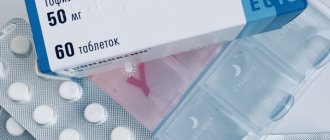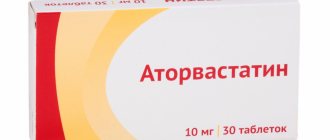Taurine is an amino acid containing sulfur. Necessary for fat metabolism, serves as a neurotransmitter in the central nervous system. It comes from food of animal origin and is independently synthesized in the body; with a lack of the substance, various health problems arise.
How the substance is used in ophthalmology, we will consider in this article.
Introduction
Taurine is a β-amino acid found in very high concentrations in most cells of the body, especially in excitable tissues. Although taurine has many functions in mammals, its cytoprotective properties have attracted particular attention from researchers because they significantly alter the health and nutritional status of a subject. The ability of taurine to regulate fundamental processes occurring in the cell, changing the balance of life and death in it, has aroused interest in the study of its physiological functions. The results of these scientific works have stimulated research into the therapeutic effects of taurine and its nutritional value, from which encouraging conclusions have been drawn [1, 2]. Of particular note is a World Health Association study involving 50 populations in 25 countries, which found that increased taurine intake was associated with a reduced risk of hypertension and hypercholesterolemia [3, 4]. Taurine supplementation also leads to a decrease in body mass index and levels of inflammatory markers in obese women [5]. Thus, the cytoprotective effect of taurine improves human health.
Interactions
When the ratio of taurine to caffeine is low, taurine enhances the sleep-suppressing effects of caffeine. At higher ratios, taurine has the opposite effect and negates the effects of caffeine ().
Synergism with carnitine
L-carnitine and taurine in the body may work together to improve heart health. In rat muscle cells, L-carnitine and taurine stopped the reproduction (proliferation) and hardening of muscle cells. This can prevent the hardening of blood vessels and stop the accumulation of plaque, thereby preventing heart disease or atherosclerosis ().
Congestive heart failure
Taurine is approved for use in the treatment of congestive heart failure (CHF) in Japan [17]. Like other drugs used to treat CHF, taurine not only reduces symptoms (exertional dyspnea and edema) but also eliminates or reduces the need for other drugs such as digoxin [17]. Taurine has a moderate positive inotropic effect and promotes natriuresis and diuresis, but its main therapeutic effect when taken chronically is to reduce the action of norepinephrine and angiotensin II, which play a role in reducing myocardial performance through increasing afterload pressure, ventricular remodeling and fluid redistribution. Taurine effectively reduces the unwanted effects of norepinephrine through its ability to reduce excess catecholamines (via changes in Ca2+ transport) and attenuate cell signaling (via changes in Ca2+ transport, reactive oxygen species and protein phosphorylation). Although recent studies have shown improvements in exercise capacity in patients with CHF with taurine use [18], it remains unknown whether taurine reduces the risk of heart failure in the general population. In addition, the reduction of mortality rates in patients with CHF when taking taurine has not been studied. There is evidence to suggest that taurine may prolong the lifespan of patients with CHF because it increases the myocardial high-energy phosphate content, which is an important determinant of mortality among patients with CHF [8].
Precautionary measures
Pregnant women should avoid using taurine supplements because they may cause insulin resistance and obesity in the baby.
Additionally, taurine and taurine-containing energy drinks should not be mixed with alcohol.
It is important to use high quality taurine supplements.
Reviews of people who took taurine
- “I have been taking three 500mg capsules regularly for two months and have seen a reduction in overall anxiety and mood swings.”
- “Helped relieve my depression.”
- “Good for the liver, heart and more.”
- “I read that taurine helps control blood sugar levels, and since taking taurine my glucose levels have improved significantly.”
- “I felt weak all the time when taking it, taurine is definitely not for those with low blood pressure.”
Hypertension
Several animal models have shown that taurine supplementation prevents the development of hypertension, with the reduction in blood pressure (BP) appearing to be mediated by a combination of Ca2+ reduction, reduction in oxidative stress, sympathetic and inflammatory activity, and improvement in renal function [19]. .
The results of two clinical studies confirm that taurine intake leads to a decrease in blood pressure in patients with arterial hypertension [20, 21]. Katakawa et al. (2016) [20] explained this by improving endothelial function due to reduced oxidative stress, Sun et al. (2016) [21] - the vasodilating effect of taurine. In a study by Sun et al. It has been shown that in patients with normal and high normal blood pressure, taking taurine (1.6 g/day) for 12 weeks. led to a decrease in systolic blood pressure by 7.2 mmHg. Art., diastolic blood pressure - by 4.7 mm Hg. Art., and the effectiveness of taurine was higher in individuals with higher blood pressure. Plasma taurine concentration increased 1.5-fold, which correlated with a decrease in blood pressure and was also consistent with the results of a previous epidemiological study by Yamori et al. (2010) [22], who found that people who consumed more taurine had lower blood pressure. In addition, Ogawa et al. [23] previously found that plasma taurine levels are decreased in patients with essential hypertension. In animal models, taurine deficiency has also been shown to accelerate the development of hypertension in single-kidney rats fed a high-salt diet. A negative correlation was found between plasma taurine content and blood pressure in rats with spontaneous hypertension. In a clinical study by Sun et al. [21] associated a decrease in blood pressure with taurine consumption with an improvement in flow-dependent and nitroglycerin-dependent vasodilation, which was not observed with placebo. In addition to an increase in plasma taurine levels, an increase in H2S was observed, which contributed to a decrease in blood pressure by inhibiting the signaling cascade in the vasculature induced by transient receptor potential channel 3. Further research is needed into the effect of H2S levels on blood pressure in comparison with the effect of known regulators of vascular function (Ca2+ ions, neurohumoral factors and nitric oxide).
Safe dose
The European Food Safety Authority (EFSA) considers taurine safe. This assessment refers to a daily dose of no more than 6 g and a period of use of one year. In the US, a dose of 3 g per day is considered safe. This assessment is based on clinical data.
A higher dose is not indicated because we obtain a certain amount of taurine from food. If your diet includes enough fiber and is supplemented with seafood, you will get about 500 mg of taurine in just one meal. It is important to note that taurine can have a calming or sedative effect when taken in large quantities (more than 1 g) throughout the day. For therapeutic purposes, taurine can be prescribed in doses greater than 3000 mg.
Atherosclerosis
There are several possible mechanisms for reducing atherogenesis with taurine supplementation.
First, in many studies in animals with atherosclerosis, the use of taurine reduced serum cholesterol levels. During the decline in serum cholesterol levels, hepatic cholesterol levels decreased more rapidly, mainly due to an increase in 7α-hydroxylase activity, which accelerates cholesterol degradation. Since there was a correlation between lower serum cholesterol levels and the treatment dose of taurine, it was assumed that increased expression of the CYP7A1 gene in the liver played a role in regulating serum cholesterol levels. Also, treatment with taurine is associated with a decrease in the activity of 3-hydroxy-3-methylglutaryl-CoA reductase [24].
Secondly, it was shown that contact of liver cells within 24 hours with a medium containing taurine leads to a decrease in the biosynthesis of cholesterol esters and triglycerides. Since the content of triglycerides and cholesteryl esters in the liver determines the assembly of lipoproteins in the endoplasmic reticulum of the liver, taurine specifically inhibits the assembly and secretion of lipoproteins containing the structural protein apolipoprotein B100 (apoB100) [24, 25]. ApoB100 is the primary structural protein of both low-density lipoproteins (LDL) and their precursors, very low-density lipoproteins.
Thirdly, taurine protects endothelial cells of vascular tissue from glucose- and oxidized LDL-induced toxicity, which is an early stage in the development of atherosclerosis [26]. It is possible that taurine also protects endothelial cells from homocysteine-induced endoplasmic reticulum stress and apoptosis by reducing hyperhomocysteinemia [27].
Fourth, taurine suppresses the proliferation of vascular smooth muscle cells caused by platelet-derived growth factor-BB (PDGF-BB), which plays an important role in the development of atherosclerosis [28]. Taurine modifies the activity of phosphatase, which dephosphorylates the PDGF-β receptor (a strong chemoattractant and proliferative factor for vascular smooth muscle cells).
Fifth, taurine reduces the expression of oxidized low-density lipoprotein receptors (which mediates the uptake of oxidized LDL into endothelial cells) and reduces the incidence of stenosis in rabbits with oxidative stress from iliac artery balloon injury [29].
Finally, sixthly, inhibition of atherosclerosis may occur due to the anti-inflammatory effect of taurine. The WHO-CARDIAC epidemiological study showed that the inclusion of taurine in the diet correlates with a decrease in mortality in patients with coronary heart disease [30]. Elvevoll et al. (2008) [31] found that taurine enhances the effectiveness of omega-3 fatty acids in reducing total cholesterol, LDL and triglycerides.
Ischemia-reperfusion injury
The effects of taurine, such as antioxidant effect, modulation of Ca2+ ions, osmoregulation, regulation of protein phosphorylation and high-energy phosphate, influence the outcome of ischemia-reperfusion injury (IRI). To date, the use of taurine is limited to heart transplantation and coronary artery bypass grafting (CABG). Several studies have shown the benefits of using taurine as a component of cardioplegic solutions or saturating hearts with taurine before using them as donors. In addition to oxidative stress and edema, decreased taurine levels in IRI result in decreased Na+ levels, which reduce osmotic stress and Ca2+ overload [16, 32]. In addition, rapid intravenous infusion of taurine before CABG prevents oxidative stress and cell necrosis [33].
Tablets, capsules or powder
Whether you take taurine tablets, capsules or powder depends entirely on your taste. The powder form is more versatile because it can be mixed with food or drinks. With tablets and capsules it is easier to calculate the correct dosage. Taurine supplements are also available in combination with other amino acids or ingredients.
But here, too, it is important to pay attention to quality, otherwise the product may contain unnecessary additives, dyes or preservatives. Taurine supplements are typically free of gluten, sugar, gelatin, nuts and soy. Therefore they are also suitable for allergy sufferers, vegans and vegetarians.
The role of taurine in metabolic diseases
Mitochondrial disease (MELAS)
The characteristic symptoms of MELAS (mitochondrial encephalomyopathy, lactic acidosis, stroke-like episodes) also develop with taurine deficiency [34], which is explained by the similarity of the pathophysiology of these two conditions. MELAS is caused by specific point mutations in the region of DNA encoding leucine tRNA (tRNALeu(UUR))[8]. The mutations appear to alter the structure of the tRNA, preventing the conjugation of taurine to the uridine base tRNALeu(UUR). Modification of the uridine base alters the interaction of the UUG codon with the AAU anticodon tRNALeu(UUR), thereby altering UUG decoding [35]. Taurine deficiency also appears to result in decreased formation of the taurine conjugate, 5-taurinomethyluridine-tRNALeu(UUR), which is associated with decreased mitochondrial taurine content [8]. Taurine deficiency reduces the expression of UUG-dependent proteins, including ND6, a subunit of complex I. Because ND6 plays an important role in complex I assembly, taurine-mediated reduction in ND6 levels leads to the conditions noted in MELAS: lactic acidosis, decreased complex I activity, and oxygen consumption. Impaired respiratory chain function results in increased superoxide production and decreased ATP production, which plays a central role in the development of myopathy and encephalopathy in MELAS.
Diabetes
Plasma and platelet taurine levels are reduced in patients with type 1 diabetes mellitus (T1DM). A study of 711 overweight patients with diabetes found that plasma taurine levels were associated with decreased insulin sensitivity [36]. Indeed, hyperglycemia-mediated decreases in taurine levels are observed in most major target organs of diabetes (kidneys, retina, and neurons) [37]. In T1DM, insulin deficiency is initially observed, which slows down glucose metabolism and increases the metabolism of fatty acids, while against the background of taurine deficiency, dysfunction of the respiratory chain, increased glycolysis and decreased oxidation of glucose and fatty acids have been identified [9]. Taurine is necessary for the normal functioning of β-cells. Thus, it was noted that the number of pancreatic β-cells decreases in 12-month-old mice with taurine deficiency (TauTKO line).
In diabetes, the animal's body undergoes pathological changes with age, since oxidative damage to mitochondria leads to dysfunction of the respiratory chain in the later stages of the disease. Mitochondrial function and biogenesis are also influenced by diet and physical activity. Therefore, with aging and dietary modification, similar features inherent in both diabetes and taurine deficiency are revealed. In this regard, an interesting fact [38] is that taurine deficiency is a necessary condition for creating a model of diabetic nephropathy.
Convincing data have accumulated on the improvement of symptoms associated with diabetes, obesity and metabolic syndrome with the use of taurine [37]. In a number of animal studies, especially in T2DM, treatment with taurine led to a decrease in the degree of hypoglycemia, which reduced the risk of diabetic complications [39].
Several mechanisms may be involved in the regulation of hyperglycemia in animals with diabetes receiving taurine. First, taurine improves respiratory chain function and increases ATP production, which improves pancreatic β-cell function and insulin secretion [8, 40]. Secondly, hyperglycemia and hyperlipidemia are associated with increased production of reactive oxygen species in mitochondria. In pancreatic β-cells, fatty acid-mediated reactive oxygen species production appears to reduce insulin secretion, which is compensated by taurine treatment. Third, mitochondrial dysfunction can provoke insulin resistance (IR) [46]. Haber et al. (2003) [41] found that taurine supplementation prevented IR and oxidative stress induced by hyperglycemia. Thus, taurine prevents the development of complications of T2DM, but the mechanism remains unclear, largely because it is impossible to separate the effect of taurine on mitochondria from its effect on insulin secretion and action.
In a streptozotocin-induced model of T1DM, it was shown that plasma glucose levels remained unchanged during taurine treatment, but the severity of T1DM complications was reduced, which was explained by a decrease in cellular stress (ER, oxidative and inflammatory) and mitochondrial dysfunction [37]. Trachtman et al. (1995) [42] were the first to establish the effectiveness of taurine in reducing the risk of diabetic complications. Thus, in male rats administered streptozotocin, diabetic nephropathy (characterized by increased glomerular filtration rate, glomerular hypertrophy, proteinuria and albuminuria) developed, while administration of taurine led to a 50% decrease in proteinuria, a significant decrease in glomerular hypertrophy and tubulointerstitial fibrosis. Because taurine also prevents increases in renal cortex levels of malondialdehyde (a marker of oxidative stress) and glycol oxidation products (markers of advanced glycation end products), the protective effects of taurine have been attributed to the suppression of oxidative stress and glycation. Ikubo et al. (2011) [43] found that rats with diabetes treated with streptozotocin developed vascular defects associated with oxidative stress, without changes in blood glucose levels. Taurine also inhibits apoptosis in cellular models of glucose toxicity [26].
Obesity is a disorder involving IR, hyperlipidemia, hyperglycemia, and inflammatory responses associated with an increase in the number of adipocytes. Taurine has shown effectiveness in suppressing inflammatory reactions and reducing body weight in obesity. These effects and their mechanisms are discussed in the review by Murakami (2015) [44].








